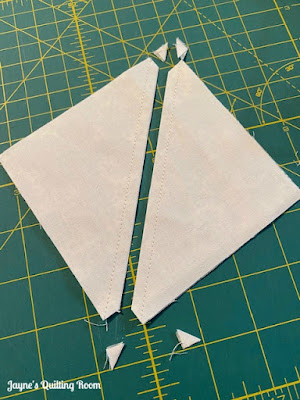To make my 10.5" (unfinished) Ohio Star block, I need to make four hourglass units which will become the points of the star. That unit needs to measure 3.75" so I begin with 2 white squares and 2 blue squares which measure 4.5". Layer right sides together and draw a diagonal line on the light fabric.
Sew a scant quarter-inch away from both sides of the line. It is easy to do a lot of these at one sitting by chain piecing. The pencil line becomes the cutting line after stitching. If making lots of these, then rotary cutting is faster. Whenever I am making only a few, I will often use the grandma method - scissors.
This next step is entirely optional, but I have the habit of cutting away the "dogears" on triangles. So, take the time, if you like. It won't affect the finish either way.
Now head to the ironing board and press open. Press seam allowance to the dark, always. Be careful at this pressing stage - you don't want to stretch the bias, and you want the seam to be flat and crisp. In the picture below, the top HST (half-square triangle) looks like I have stretched it a bit as the bottom edge and the right edge look somewhat wavy. That's an indicator that the bias stretched. The bottom HST looks pretty good.
After pressing, lay two HSTs right sides together. The seam lines should rest together nice and tight. Draw a diagonal line.
Sew on either side of the drawn line, cut apart on the line, and trim the dogears.
Press open, again being careful not to stretch the bias. This started out as a blue 4.5-inch square and a white 4.5-inch square. Now, you have 2 hourglass blocks that should measure 3.75 inches.
And that completes the hourglass tutorial. But what do you do with the hourglass block? Well, my current project calls for 90 Ohio Star blocks, which are made with hourglass sub-units. One Ohio star needs 4 of these units. Add five 3.75-inch blocks, four of background and one of the blue. Sew together in 9-patch style.
Now, what if you changed that center square? How would that change the look of the block? I love to experiment, so let's see what we can come up with.
I laid a yellow block over the center just to get an idea of how a 3-color star would look. I seriously considered making my blocks this way, but ultimately preferred to keep each block simpler with 2 colors.
It is possible to get more creative with fabric placement using three colors. Here's what I will start with for the hourglass units.
Determining that I want my star points to be red, I use 2 red squares, one background square and one accent square.
I sew one red to the background and the other red to the accent. Trim and place one of each combination together to make the hourglass unit.
I now have a red star on a gray background with a gold accent in the center.
Adding a fourth color gives me yet another variation. Check out this star with a navy center.
I could go on and on changing out fabrics. Think of how a beautiful floral in the center would change things. Or a variety of prints for each part. The possibilities are endless.
One more thing I will show you: what you have when you don't trim the dogears. It is no big deal, but the longer I quilt, the more I clean up little things like this.
Take some time to play around with all the possibilities. If you are worried about sizing, do it the way I did. Begin with a set measurement for your squares to make the hourglass units. I just randomly chose to start with 4.5 inches. I could just as easily have use 2.5 inches or 3 inches for a smaller star. Or I could have use a larger square for a larger star. I made the hourglass block, measured it, and that became the size I knew I needed to cut for my remaining block parts.
Please let me know if you try making hourglass blocks with this tutorial. If you have trouble, I will gladly revise any parts that are confusing.
Happy Quilting, Friends!


















No comments:
Post a Comment
Feedback on my posts is always welcome!